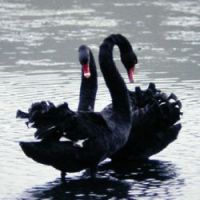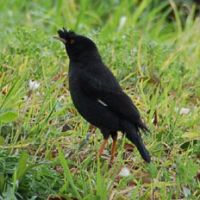For several years now I have been at work on a new book — to be titled "Field Guide to the Birds of East Asia" — that is due to be published later this year. You may think it would be an easy matter to put together such a tome; after all, ornithologists and birdwatchers have been studying birds for decades, if not centuries.
Isn't writing such a book just a matter of collating all that information?
Gaps and contradictions
Sounds easy, doesn't it, but you might be amazed at how many gaps there are in the information net; how many contradictions there are in what has already been written; and how many debates continue over whether a species has been reliably seen or not.
I have friends who were among those lucky enough to see the only Hooded Merganser (a North American duck) ever recorded in East Asia. In 1997, this bird remained for the best part of a whole winter at Lake Utonai in western Hokkaido, yet it was seemingly not photographed and has been omitted from most bird books that have been published in the last decade.
Years earlier, on a visit to Honshu in the early 1980s, I was fortunate enough to see a Mistle Thrush. I hasten to point out that I had not found it; I merely went to see it. But when the Ornithological Society of Japan published their "Check-List of Japanese Birds" in 2000, it was missing from the main text and allocated a single line in "Appendix B," where the code number 5 beside its name indicated "the document of record is not published (sic) by 1 March 1999."
I was so surprised by this statement — especially given that the bird was included in a number of field guides, including 1988's "A Guide for Bird Lovers" — that I contacted the Ornithological Society and offered my own photographs of the bird as proof of its genuine appearance in Japan. I was asked to publish a paper on it!
It was an odd experience; I was not the original finder, nor the only photographer, but as it turned out I was the only observer who came forward with notes and photographs, and who was willing to publish the record. It was not exactly momentous science, but on such slim threads hang many records; and without publication of such records, how will future scholars be able to look back through time and draw comparisons of what we have gained or what we have lost as species shift and change their distributions?
Entering a minefield
When I first began my field-guide project, I realized that I was entering a minefield of dispute when it came to records — after all, some observers publish their records, but others do not, and, in effect, the unpublished records cease to exist once their observers are no longer with us.
I was soon struck by another odd aspect, and that was the extent of attention paid to certain species, but not to others. I found that a great deal of information was often available on the most rare species, yet some of the most common ones were ignored.
When the Wild Bird Society of Japan produced its "Field Guide to the Birds of Japan" in 1982, it omitted one of the country's commonest species — the Rock Pigeon. There was no map and no species account, though admittedly there were three tiny illustrations of different color phases. The Japanese Association for Preservation of Birds omitted it entirely from that 1988 edition of its "A Guide for Bird Lovers."
In my reference book, "The Birds of Japan," published in 1991, I stuck my neck out and allocated 14 lines to that common species, but only three to its related rarity, the Stock Dove. The much more recent (2000) "Nihon no Tori 550 (550 Japanese Birds)" allocates an entire page with three large photographs to the Stock Dove, which is still an extreme rarity in Japan, but gives only half a page and two small photographs to the Rock Pigeon, a species that can be found commonly in every city in the land and around many a farm and village in rural areas too.
It seems that biologists may be somewhat biased in their approach. Not so much racist as speciesist!
Nations sensitive to their biosecurity are passing laws to regulate, control or manage introduced organisms, whether they are moths that may damage fruit orchards, molds that may damage grains, animals that carry disease, or plants that run wild and outcompete native species. Unfortunately, there are those still misguided enough to think it's "fun" or "interesting" to introduce species outside their native ranges, without realizing the enormous ecological damage they can inflict.
Japan, at present, is suffering from a large number of devastating alien introductions ranging from Black Bass and Bluegill to the Raccoon. Sometimes it takes years even to recognize the impact of such species, by which time it is difficult to rectify the situation. Yet strangely, while some introduced species run rampant very quickly, others take decades to establish themselves and even then hardly spread at all. It depends very much on their ecological needs and whether those needs are easily met. Some species come and go, perhaps establishing themselves for a while before dying out, only to be reintroduced again.
The Budgerigar seems to fit into that category.
These pretty birds regularly escape from captivity and readily join flocks of other birds such as Tree Sparrows, but although they may breed in the wild here, it probably only takes a winter cold spell to wipe many of them out.
However, the hardy Rose-ringed Parakeet seems to have become established as a successful colonist of urban and suburban parks, where large trees provide the cavities it needs to nest in. Tokyo seems to have a well-established and thriving colony.
The Crested Myna, a relative of the starlings, is another species that seems to have been here for a long time, several decades to my knowledge, but although it is regularly sighted in the Tokyo/Yokohama area, it appears that it hasn't been able to spread much further — perhaps it is unable to compete with the native, and ubiquitous, White- cheeked Starling.
A reader reports
Some birds have been introduced as "ornamentals" to grace parks and gardens, such as the Mute Swan and the Black Swan; while the former has become well-established and breeds at a number of locations in Hokkaido and Honshu, the Black Swan remains much less common in Kyushu and Honshu, though a reader of this column has reported seeing one recently in Hokkaido, so perhaps it's spreading too.
Meanwhile, other species gain a toehold and then very slowly spread out into an unoccupied niche. A small, colorful bird known as the Red-billed Leiothrix (or Peking Robin) seems to have achieved this feat. Having escaped, or been released from captivity, it has found the woodland under shrub layers of dwarf bamboo much to its liking. It is a bamboo specialist, and seemingly few if any other birds occupy that niche in Japan, so the Leiothrix appears to have a vacant niche to spread into. Or does it?
So often our understanding of natural habitats and the way in which they function is simplistic, or even entirely lacking. We often find out the hard way when the consequences of introductions begin to make themselves felt. At the very least we need to keep an eye on any new additions to the fauna and flora, so that we can monitor changes in their populations.
If you encounter any mystery birds, mammals or plants that you think may have been introduced, and would like help with their identification, do please let me know at [email protected] — and don't forget to take photographs and some note of when and where you made your observation.





















With your current subscription plan you can comment on stories. However, before writing your first comment, please create a display name in the Profile section of your subscriber account page.